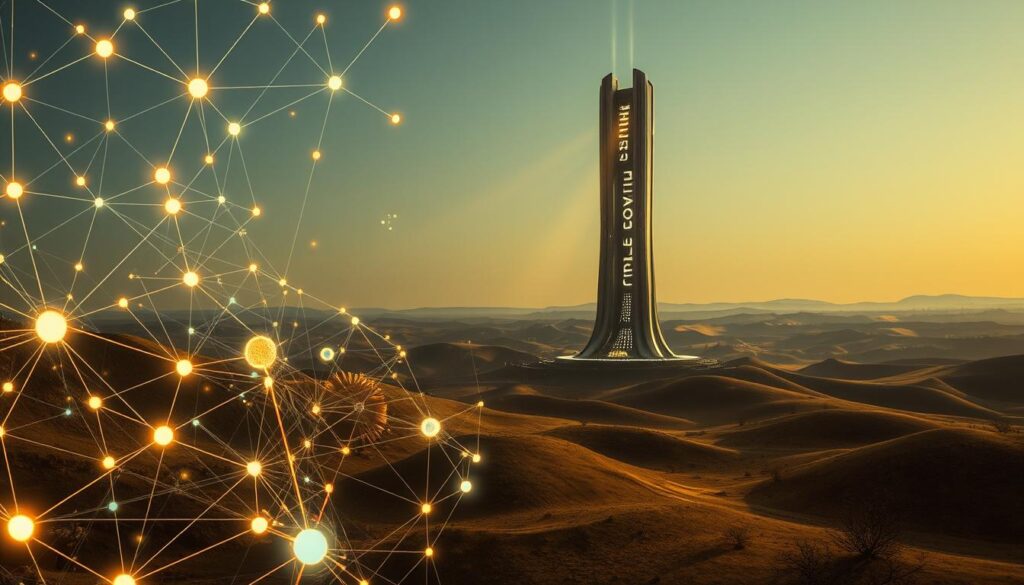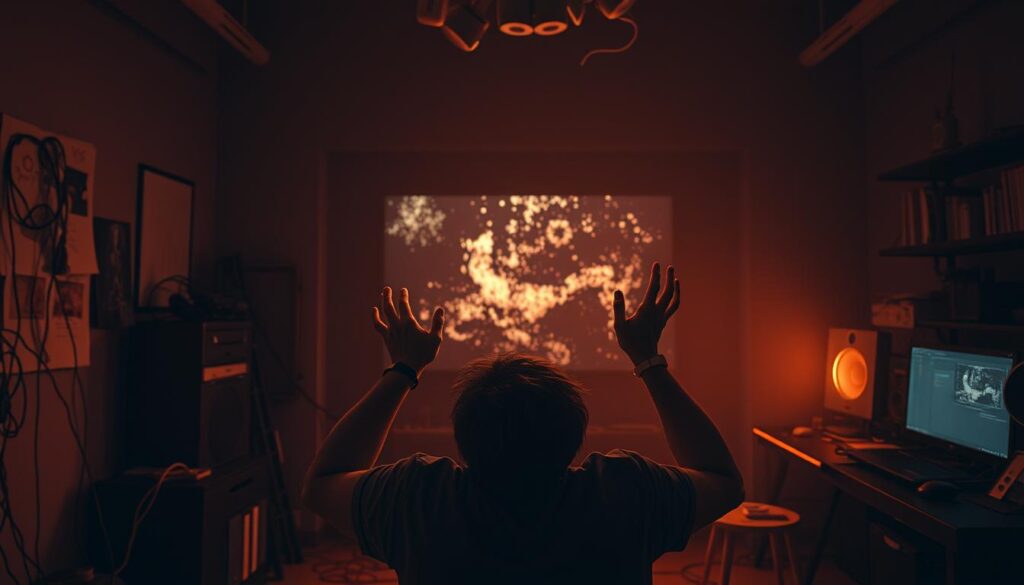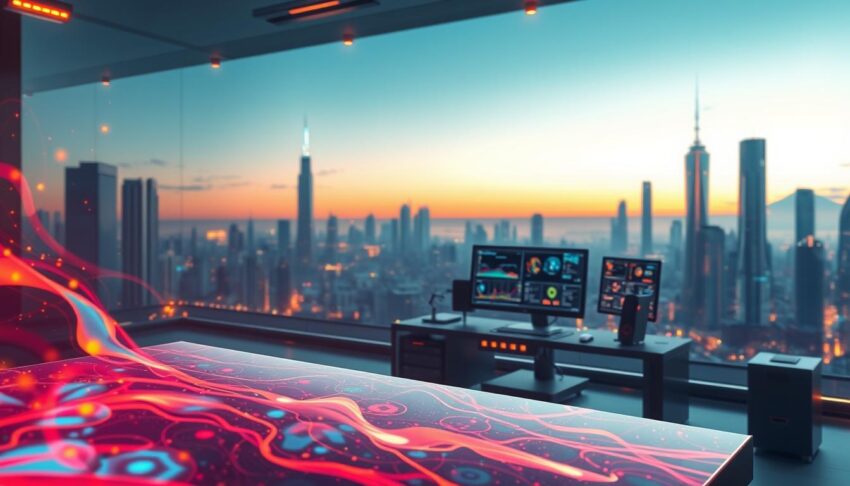What if the future of creativity is in AI, not just artists? Generative AI is changing how we make content in many fields. It brings new life to art and music, changing the creative world.
Learning about Generative AI is key for the future of art and innovation. It shows how AI can make our creative work better and open up new artistic paths.
Key Takeaways
- Generative AI revolutionizes the creative process across multiple industries.
- Integration of AI technology opens innovative pathways for artistic expression.
- Understanding generative models is crucial for future creativity.
- AI enhances collaboration between technology and artistic endeavors.
- The impact of AI on creativity is significant and transformative.
Understanding Generative AI
Generative AI is a new part of artificial intelligence. It can make things on its own. This is different from old AI, which just solves problems.
Generative AI uses special algorithms to make new things. It changes many areas by bringing new ideas and art.
Definition and Mechanisms of Generative AI
Generative AI uses cool algorithms like GANs and VAEs. These learn from lots of data to make new stuff. It can make art, music, and text that's creative.
This tech lets AI not just copy but also create. It's a big step up from old AI ways.
How Generative AI Differs from Traditional AI
Old AI looks for patterns and makes choices based on past data. But Generative AI wants to make new things. It's all about being creative and finding new ways to do things.
This shows how AI has grown. Generative AI is key to making progress in many fields.
The Role of Artificial Intelligence in Creativity
Artificial intelligence changes how we make art today. It helps artists do their work better and faster. This lets them try new things and come up with ideas they never thought of before.
Enhancing Artistic Processes with AI
AI is a big help in making art better. Tools like Adobe Sensei and RunwayML do the easy stuff so artists can focus on being creative. This lets them try out new styles and ideas, making their work more interesting.
AI as a Collaborative Tool for Creators
AI helps artists work together and come up with ideas. It makes it easier to get started on a project. This way, artists can focus on making their work special and personal.
| AI Tool | Function | Creative Benefit |
|---|---|---|
| Adobe Sensei | Automates design tasks | Increases workflow efficiency |
| RunwayML | Generates visual and audio content | Inspires new forms of art |
| DALL-E | Creates images from text inputs | Expands creative possibilities |
Generative AI Applications Across Industries
Generative AI is changing many fields. It makes creativity better in many areas. It helps make new content that people love.
Transforming Music and Art with AI
In music, AI tools like OpenAI's MuseNet create new songs. Musicians can try out new sounds easily. Artists use Artbreeder to make unique art, breaking old art rules.
This mix of tech and creativity inspires artists and musicians.
Generative AI in Fashion and Design
Fashion gets a big boost from AI. Designers use AI to make new designs fast. This helps brands make many different styles quickly.
This makes design faster and lets customers get what they want. It makes shopping better and more fun.
Innovative Solutions in Film and Animation
AI changes how we make movies and cartoons. It helps with backgrounds and looks. This lets creators work on the story more.
It makes making movies easier and better. This means stories are told in a more exciting way.
Machine Learning and Its Impact on Creativity
Machine learning is key in making generative AI. It changes how we make art and connect with it. Knowing how it works helps us see its role in art.
Machine Learning Algorithms Explained
Machine learning uses many algorithms. These help AI learn from data and do things on its own. Some important ones are:
| Algorithm Type | Functionality | Application in Creativity |
|---|---|---|
| Decision Trees | Make decisions based on data attributes | Used in generating unique storylines in narrative design |
| Reinforcement Learning | Learn through trial and error to maximize rewards | Creating interactive experiences in video games |
| Unsupervised Learning | Identify patterns in data without labeled outcomes | Discovering new art styles through data clustering |
The Intersection of Machine Learning and Artistic Expression
Machine learning and art come together in new ways. Artists use these tools to make their work more exciting. This mix changes how we think about making art today.

Deep Learning Techniques Driving Creative Solutions
Deep learning is changing the creative world. It uses advanced neural networks to help artists and creators. This tech makes new and exciting things possible.
Let's look at how neural networks work and their role in making new things.
Understanding Neural Networks in Creativity
Neural networks are key to deep learning. They have layers that work together to understand information. CNNs are great for pictures, and RNNs are good for things that happen in order.
These networks help make new art and make work easier and more accurate.
Deep Learning Models for Generative Tasks
Tools like TensorFlow and PyTorch help make models for creating new things. These models can make pictures, music, and more. They learn from what already exists.
This lets humans and machines work together in new ways.
| Network Type | Primary Use | Benefits |
|---|---|---|
| Convolutional Neural Networks (CNNs) | Image Recognition and Generation | High accuracy in visual tasks |
| Recurrent Neural Networks (RNNs) | Sequential Data, such as Music or Text | Efficiency in processing time-series data |
| Generative Adversarial Networks (GANs) | Content Generation | Produces high-quality, realistic outputs |
Natural Language Processing and Creativity
Natural language processing is changing how we write stories. It gives writers tools to make their stories better. With smart algorithms, NLP can create interesting text and ideas.
Using NLP for Literary Creation
NLP helps writers tell new stories. It uses models like GPT-3 to suggest plot ideas. This makes writing more fun and exciting.
Chatbots and their Role in Creative Writing
Chatbots are key in creative writing. They help writers brainstorm and improve dialogue. Chatbots let writers try new styles and get feedback fast.
Data Science and Its Influence on Generative AI
Data science is key in making generative AI work. Good datasets are the base for these models. They help make art by using lots of data.
AI gets better with data science. This makes art more interesting and new.
The Relationship between Data and Artistic Output
AI makers use many datasets to make art. Data science helps find patterns in big data. This lets AI create art that people like.
AI can make art that fits trends but also brings new ideas. This makes creativity grow.
Data Analysis for Generative Model Training
Data analysis is important for training AI. It uses things like clustering and regression. This makes AI art better.
AI finds important details in data. This makes the art it creates better. Data science and AI together lead to new ideas in art.
Challenges of Using Generative AI in Creative Fields
Generative AI brings big challenges to creative fields. It raises important ethical considerations about AI content's truth. Knowing these challenges helps us talk about AI in art.
Ethical Considerations in AI-Generated Content
Generative AI makes us think about copyright and who owns creative work. Artists worry about AI using their styles without asking. It's hard to tell if AI art is truly creative.
AI can show old biases, making art unfair. This makes us wonder who should be blamed for biased art.
Limitations of Current Generative AI Technologies
Even with progress, AI has big limitations. It's not always right, which can mess up art. AI art might not feel real, which can upset people.
This makes artists doubt if AI is good for art. We need to keep working on AI to help, not hurt, human creativity.

Future Trends in Generative AI Technology
Generative AI is changing fast, bringing big changes to creative fields. It will be used more to make content just for you. With better data, art and media will fit what you like better.
It's key to know these trends if you want to keep up with creativity's changes.
Predictions for AI in Creative Industries
As generative AI grows, we see big changes in creative fields:
- Artists and AI tools will work together more, changing how we make art.
- AI will help make content just for you, starting new ways to make money in art, design, and entertainment.
- AI will help share and get feedback fast, making making art faster.
Emerging Technologies and Innovations in Generative AI
New tech will shape the future of generative AI. We expect big changes from:
| Emerging Technology | Impact on Generative AI |
|---|---|
| Quantum Computing | Makes AI learn and create faster, with better results. |
| Augmented Reality | Makes art come alive, opening up new ways to create. |
| Advanced Neural Networks | Makes AI art more real and varied, with better quality. |
Conclusion
Generative AI is changing how we create in many areas. It uses smart algorithms and deep learning to help artists and writers. This technology makes old ways better and lets us try new things together.
Using generative AI shows how tech can help us more. Looking ahead, we'll see new kinds of art and stories. These will touch our hearts and minds in ways we can't imagine yet.
By using generative AI, creators can do more and try new things. Artists and tech experts working together will lead to amazing things. This mix of creativity and AI will open up endless possibilities.
